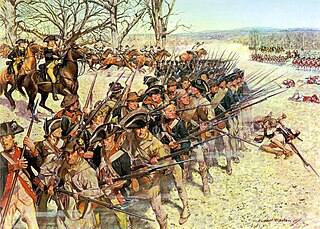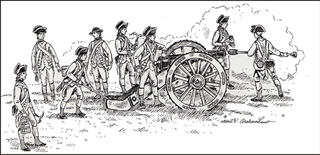The 1st New Hampshire Regiment was an infantry unit that came into existence on 22 May 1775 at the beginning of the American Revolutionary War. John Stark was the regiment's first commander. The unit fought at Chelsea Creek and Bunker Hill in 1775. On 1 January 1776, while engaged in the Siege of Boston, the unit was renamed the 5th Continental Regiment. In the spring it was sent to Canada where the New Hampshire soldiers fought at Trois-Rivières and later helped defend the area around Lake Champlain. Late in the year, the 5th Continental Regiment was transferred south to George Washington's main army where it fought at Trenton.
The 1st Massachusetts Regiment was an infantry unit of the Continental Army that fought during the American Revolutionary War. It was first authorized on 23 April 1775 in the Massachusetts State Troops as Paterson's Regiment under Colonel John Paterson and was organized at Cambridge, Massachusetts. It consisted of eleven companies of volunteers from Berkshire, Hampshire, Suffolk, Middlesex, Worcester, and York counties in Massachusetts and the county of Litchfield in the colony of Connecticut. The regiment was adopted into the main Continental Army on 14 June 1775 and was assigned to William Heath's brigade on 22 July 1775. On 1 January 1776 the regiment was consolidated with Sayer's and Sullivan's companies of Scammon's Regiment; re-organized to eight companies and redesignated as the 15th Continental Regiment of Heath's Brigade.
The 7th Massachusetts Regiment was an infantry regiment of the Continental Army. It was constituted on 16 September 1776, and was originally known as Alden's Regiment after its first colonel, Ichabod Alden. It was organized as seven companies of volunteers from across Massachusetts, and Mayhew's company from the 25th Continental Regiment during the later months of 1776. The regiment was assigned to the Northern Department on 9 February 1777. It was reassigned to the Highland's Department on 13 March 1777. On 12 June 1777 it was assigned to 2nd Massachusetts Brigade and three days later, 15 June 1777, it was reassigned to the 1st Massachusetts Brigade. The brigade was reassigned to the Northern Department on 1 July 1777 and the regiment was relieved from the brigade on 31 March 1778. The regiment re-organized to nine companies on 25 September 1778 and reassigned to the Northern Department on 14 June 1779. The regiment was reassigned to the New Hampshire Brigade of the main army on 23 August 1779. On 14 November 1779, the regiment was reassigned to the 3d Massachusetts Brigade in the Highland Department. On 1 January 1781, the regiment was reassigned to the 1st Massachusetts Brigade. The regiment was furloughed on 12 June 1783 at West Point, New York and disbanded on 15 November 1783.

The 2nd Rhode Island Regiment was authorized on 6 May 1775 under Colonel Daniel Hitchcock in the Rhode Island Army of Observation and was organized on 8 May 1775 as eight companies of volunteers from Providence County of the colony of Rhode Island. As part of a brigade organized under Nathanael Greene, the unit participated in the Siege of Boston during the remainder of 1775. Some elements accompanied Benedict Arnold's expedition to Quebec late in the year. The unit was renamed the 11th Continental Regiment on the first day of 1776.
The 1st Connecticut Regiment was a unit of the Continental Army, and was involved in the American Revolutionary War. The regiment was initially formed in 1776, and was active in various forms until 1783.

The 2nd Connecticut Regiment was a regiment in the Continental Army during the American Revolution. It is not to be confused with the 2nd Connecticut Volunteer Infantry Regiment which served during the American Civil War.

The 1st Maryland Regiment originated with the authorization of a Maryland Battalion of the Maryland State Troops on 14 January 1776. It was organized in the spring at Baltimore, Maryland and Annapolis, Maryland under the command of Colonel William Smallwood consisting of eight companies and one light infantry company from the northern and western counties of the colony of Maryland.
The 3rd Maryland Regiment was an infantry regiment of the Continental Army during the American Revolutionary War. It served from 1776 to 1783, mostly in the Middle Atlantic Region of the conflict.

The 4th Maryland Regiment was organized on 27 March 1777 as a part of eight companies from Baltimore, Anne Arundel and Somerset Counties. It was assigned to the 2nd Maryland Brigade—a part of the Main Army—on 22 May 1777. Assigned 27 December 1776 to the Main Army. Authorized 16 September 1776 in the Continental Army as the 4th Maryland Regiment. Reorganized 12 May 1779 to consist of nine companies. Relieved 1 January 1781 from the Maryland Brigade. Assigned 24 September 1781 to Gist's Brigade of the Main Army. Relieved 4 January 1782 from Gist's Brigade and assigned to the Maryland Brigade, an element of the Southern Department. Disbanded 1 January 1783 at Charleston, South Carolina.
The 5th Maryland Regiment is a designation which has been held by several units over the years, not all of which necessarily share the same lineage and honors. The term "5th Maryland" has most frequently been connected to militia units in Baltimore, even though the first unit to bear the designation was formed in 1776 from volunteers in rural Maryland. The "5th Maryland" designation is the officially recognized traditional designation of the 175th Infantry Regiment, Maryland Army National Guard. This entry refers to the rural 5th Maryland, whose lineage is separate and distinct from the Baltimore 5th Maryland perpetuated by the 175th Infantry Regiment.

The 6th Maryland Regiment, active from 27 March 1776—January 1, 1783, is most notable for its involvement during the American Revolutionary war of the same years. An infantry type regiment consisting of 728 soldiers, the 6th Maryland was composed of eight companies of volunteers from Prince Georges, Queen Anne's, Fredrick, Cecil, Harford, and Ann Arundel counties in the colony of Maryland

The 7th Maryland Regiment was authorized on 16 September 1776, for service with the Continental Army and was assigned on 27 December 1776. The regiment was composed of eight companies of volunteers organized from Frederick and Baltimore counties of the colony of Maryland.
The 11th Virginia Regiment was a Continental Army regiment that fought in the American Revolutionary War.
The 2nd North Carolina Regiment was an American infantry unit that was raised for the Continental Army during the American Revolutionary War. In 1776 the regiment helped defend Charleston, South Carolina. Ordered to join George Washington's main army in February 1777, the regiment subsequently fought at Brandywine and Germantown during the Philadelphia Campaign. After most other North Carolina regiments were sent home to recruit, the 1st and 2nd Regiments remained with the main army and fought at Monmouth in June 1778. The regiment was transferred to the Southern Department and was captured by the British army in May 1780 at the Siege of Charleston. Together with the 1st Regiment, the unit was rebuilt and fought capably at Eutaw Springs. The 2nd was furloughed in April 1783 and officially dissolved in November 1783.

The North Carolina Line refers to North Carolina units within the Continental Army. The term "North Carolina Line" referred to the quota of infantry regiments assigned to North Carolina at various times by the Continental Congress. These, together with similar contingents from the other twelve states, formed the Continental Line. The concept was particularly important in relation to the promotion of commissioned officers. Officers of the Continental Army below the rank of brigadier general were ordinarily ineligible for promotion except in the line of their own state.

The Rhode Island Line was a formation within the Continental Army. The term "Rhode Island Line" referred to the quota of numbered infantry regiments assigned to Rhode Island at various times by the Continental Congress. These, together with similar contingents from the other twelve states, formed the Continental Line. The concept was particularly important in relation to the promotion of commissioned officers. Officers of the Continental Army below the rank of brigadier general were ordinarily ineligible for promotion except in the line of their own state.

The 1st Continental Artillery Regiment, also known as Harrison's Continental Artillery Regiment, was authorized on 26 November 1776 as Colonel Charles Harrison's Continental Artillery Regiment. Raised for service during the American Revolutionary War, as originally organized, the regiment comprised 10 artillery companies from Virginia. Two of the artillery companies existed since early 1776. The regiment was first assigned to the Southern Department, but in March 1778 it was reassigned to General George Washington's main army. In August 1779, the unit was renamed the 1st Continental Artillery Regiment. It continued to serve with the main army until April 1780 when it was transferred to the Southern Department. In May 1780, Maryland artillery companies formally joined the regiment, making a total of 12 companies. In January 1781, the regiment was reorganized with 10 companies. Furloughed in the summer of 1783, the regiment was disbanded in November the same year. Elements of the regiment fought at Monmouth, Charleston, Camden, Hobkirk's Hill, Eutaw Springs, Yorktown, and Combahee River.
The "German Battalion" was an infantry formation of the Continental Army during the American Revolutionary War. Authorized in May 1776 as an extra Continental regiment, the battaltion recruited ethnic Germans from Maryland and Pennsylvania.
Babcock's/Lippitt's Regiment was a regiment raised for the defense of Rhode Island during the American Revolution.









